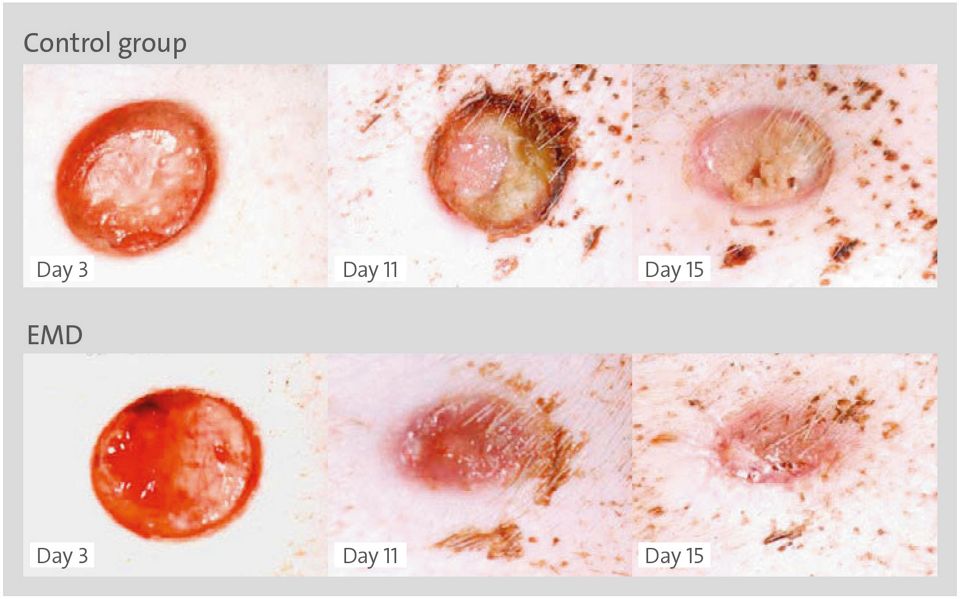Potential for clinical use in several indications outside the periodontium
Emdogain® is a purified protein extract from enamel matrix (often called enamel matrix derivatives or EMDs) in a carrier gel of propylene glycol alginate (PGA) used to restore a functional periodontal ligament, cementum and alveolar bone in patients with severe tooth attachment loss. The application of Emdogain® has set a new standard for periodontal regeneration therapy. The first studies on clinical applications with Emdogain® were published in 1997. Since then, a large number of research groups has studied the mechanism of actions of EMDs and confirmed the clinical effect in periodontal healing and regeneration. The major component of Emdogain®, amelogenins, is evolutionarily well conserved and expressed, not only in teeth but also in other connective tissues, hinting at key roles in basic biological processes. Studies report that EMDs interact directly with several cell types, suggesting that Emdogain® has potential for clinical use in several indications outside the periodontium, most notably for promoting soft tissue healing.
Exceptionally fast wound healing and minimal postoperative symptoms
The activity of Emdogain® has been compared to that of growth factors. Studies also confirm that EMDs trigger a balanced and sequenced release of important growth factors and cytokines that orchestrate the clinical effects observed after application of Emdogain®. A common clinical observation when using Emdogain® is exceptionally fast wound healing and minimal postoperative symptoms such as pain or swelling. A number of reasons for this observation have been suggested, including anti-inflammatory and antimicrobial effects. , Inspired by clinical observations in oral surgery, several investigators have studied the effect of amelogenins on healing of both acute and chronic skin wounds. The first experimental study to demonstrate that amelogenins stimulate skin wound healing showed that the amount of granulation tissue in an EMD-treated wound was significantly increased, and that wound fill and re-epithelialization of full thickness wounds progressed almost twice as fast in the presence of EMDs. The mechanisms involved in EMD-assisted skin healing have yet to be completely understood, but it has been shown that local application of amelogenins stimulates angiogenesis by inducing secretion of vascular endothelial growth factors (VEGFs) and platelet derived growth factors (PDGFs). Similar findings have also been reported in in vitro studies, , which support the idea that amelogenins in general work by stimulating mesenchymal cells to express factors that are important for healing, growth and regeneration.
Amelogenin formulation for skin wounds, based on the original Emdogain® product
The surprisingly rapid healing observed with Emdogain® in periodontal surgery and in experimental animal wound models (Fig. 1) has led to the development of an amelogenin formulation for skin wounds, based on the original Emdogain® product. Several clinical studies have shown that the observation from oral surgery sites and animal models holds true. In the first phase III randomized, clinical multi-center trial on the application of amelogenins in hard-to-heal wounds Emdogain®-treated wounds showed a three-fold reduction in mean ulcer size compared with the control group, which was treated with the PGA vehicle alone over a 12-week period. Statistically significant differences in favor of the Emdogain®-treated group were also found for reduction in ulcer-related pain and swelling. Results of the follow-up from the initial study also showed that the beneficial healing response to amelogenin was maintained six months after the initial treatment started. At the follow up, the overall number of patients with completely healed wounds was three times greater in the Emdogain®-treated group than in the control group.

Fig.: Wound healing in full thickness wounds in pigs after one application with EMDs or control (PGA vehicle only). After three days the EMD-treated wounds were significantly better vascularized than the controls as visualized here by the vivid red color and presence of blood vessels in the wound surface. After 11 days the EMD-treated wounds were closed and epithelium covered most of the wound areas. At this stage the control wounds still only showed granulation tissue with little epithelialization. After 15 days the EMD-treated wounds were covered by epithelium, while the control wounds still showed uncovered granulation tissue in central parts of the wounds.
Findings
The effect of Emdogain® on wound healing is now widely recognized. There is no doubt that this effect has a great potential for a wide array of oral surgery procedures to promote soft tissue healing and avoid post-operative complications. In addition to healthy patients, patients that are locally or systemically challenged and show a risk of impaired healing might benefit from this unique product in the future. One example is the application of Emdogain® for treatment of dry sockets and other postoperative complications, even if the treatment is instigated after the onset of the complication. The scientific documentation for the use of Emdogain® for promoting soft tissue wound healing is now solid, providing a strong base to further extend its clinical evidence and use in oral surgical procedures in general. As researchers keep unraveling the modus operandi of amelogenins and EMDs, more applications and improved procedures will probably develop, but for now Emdogain® is staged for setting yet another standard in modern regenerative treatment, this time for soft tissue management.
Note: some indications for the use of Straumann® Emdogain® may not be approved in all countries. Please check with your local Straumann sales representative for further information in this matter.
